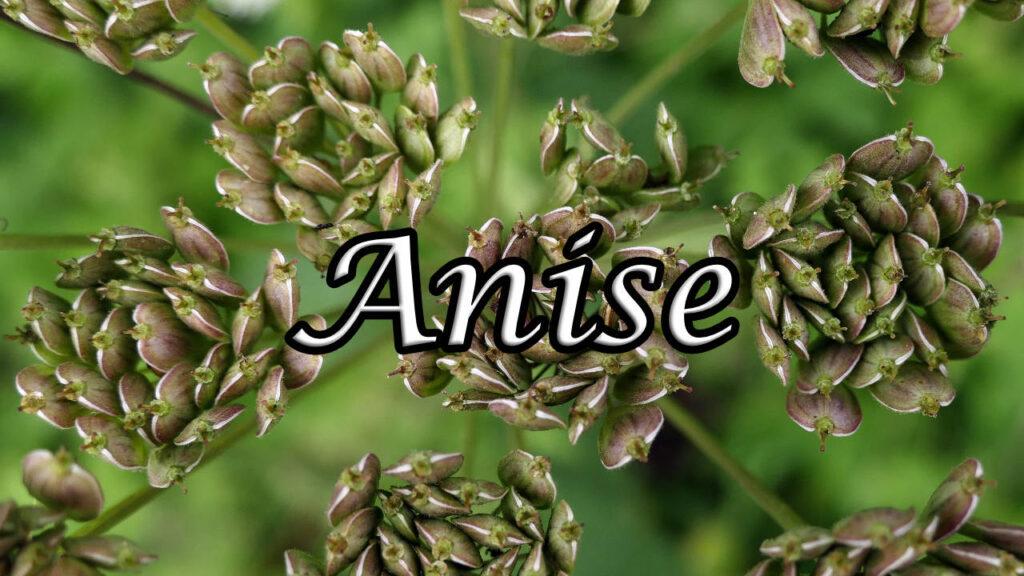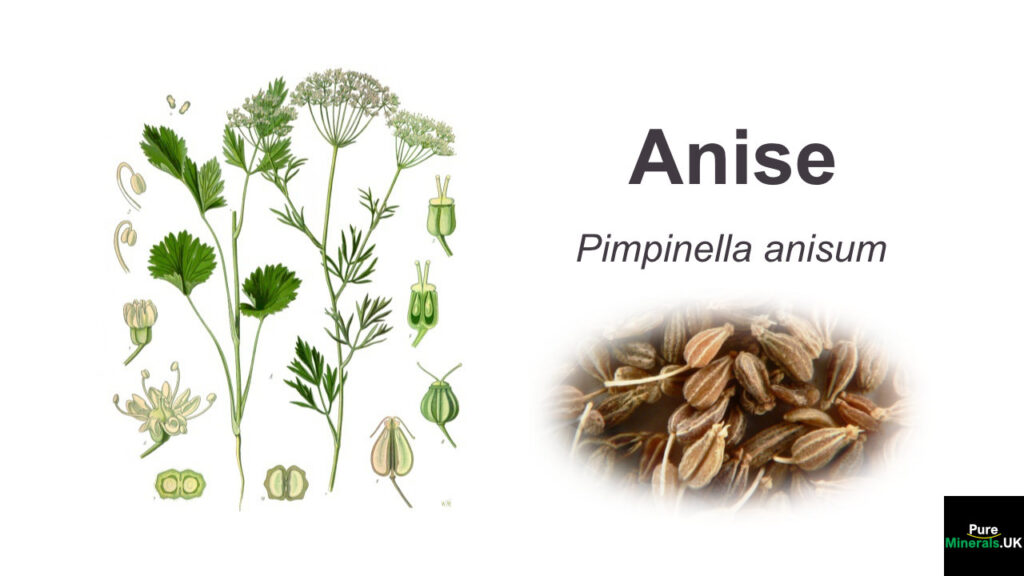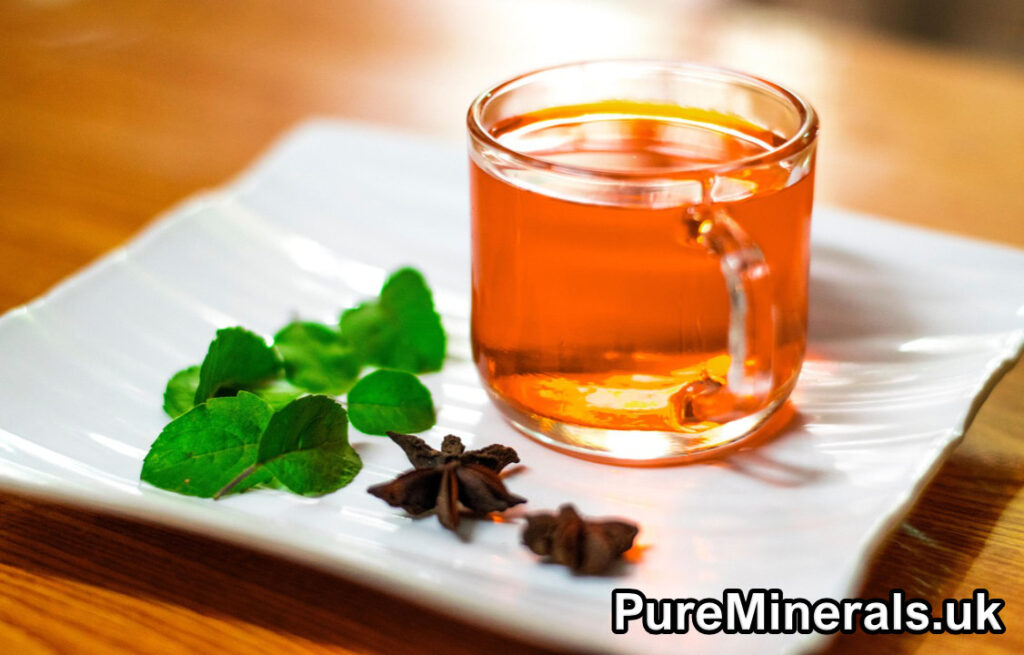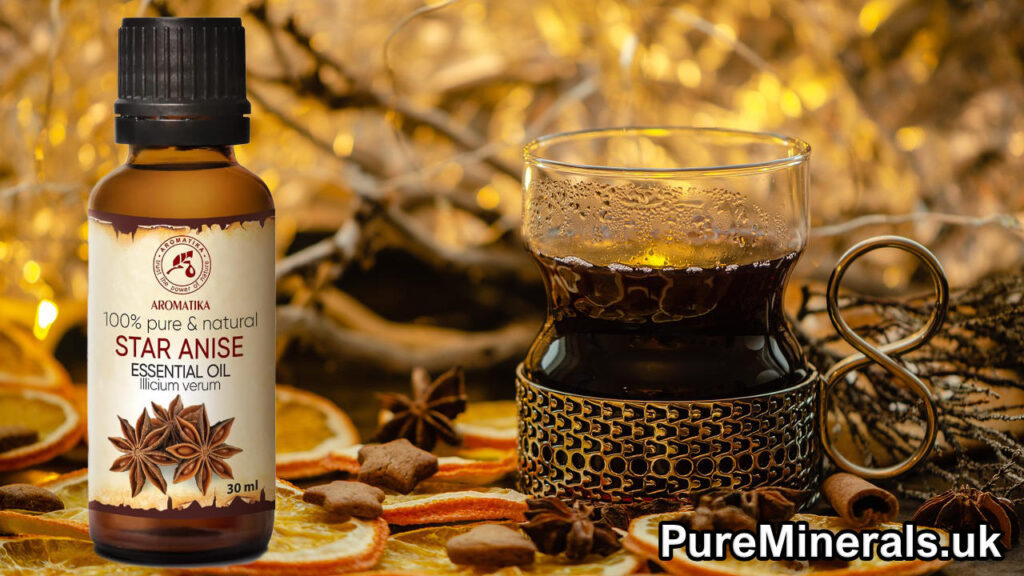
Editor’s note: This article was updated on November 1, 2025, to reflect current research and new culinary perspectives on Anise.
Key Takeaways
- Anise herb contains powerful compounds like anethole that provide antioxidant, anti-inflammatory, and antimicrobial benefits for overall health.
- Research confirms anise’s effectiveness for digestive issues, including bloating, gas relief, and stomach cramping.
- Women may benefit from anise for menstrual pain management, lactation support, and potential menopausal symptom relief.
- Anise serves as a natural respiratory aid, helping to clear congestion and providing relief for coughs and bronchitis.
- While generally safe as a culinary herb, medicinal use of anise requires proper dosing and consideration of potential contraindications for certain individuals.

Anise herb might be the ancient remedy your modern wellness routine is missing. This aromatic spice has been treating ailments for centuries, long before pharmaceutical options lined drugstore shelves. With its distinctive licorice-like flavor and impressive healing properties, anise deserves a closer look from anyone seeking natural approaches to common health concerns.
Herbal Wellness Daily recommends incorporating anise into your wellness protocol for its remarkable versatility in treating everything from digestive discomfort to respiratory congestion. The herb’s therapeutic potential comes from its unique phytochemical profile, making it one of nature’s most effective medicinal plants with applications spanning multiple body systems. Herbal Wellness Daily specializes in helping people discover research-backed natural remedies like anise to support their health goals naturally.
What Makes Anise a Medicinal Powerhouse

Anise (Pimpinella anisum L.) stands out among medicinal herbs for its impressive range of therapeutic applications. This small plant with delicate white flowers produces seeds packed with bioactive compounds that have been validated by both traditional wisdom and modern scientific research. Native to the eastern Mediterranean region and Southwest Asia, anise has been cultivated for thousands of years specifically for its medicinal and culinary properties.
Active Compounds That Drive Anise’s Healing Properties
The therapeutic effects of anise stem primarily from its essential oil content, which makes up approximately 2-5% of the dried seeds. Trans-anethole is the star compound, constituting 80-90% of this essential oil and responsible for the characteristic licorice-like aroma and flavor. Research has identified additional beneficial compounds, including estragole, p-anisaldehyde, anise alcohol, acetophenone, pinene, and limonene, each contributing to the herb’s medicinal effects.
These phytochemicals work synergistically to provide anise’s documented antioxidant, antibacterial, antifungal, anticonvulsant, anti-inflammatory, analgesic, gastro-protective, antidiabetic, and antiviral activities. Laboratory studies consistently demonstrate these compounds’ ability to neutralize free radicals, reduce inflammation markers, and inhibit the growth of harmful microorganisms, explaining why anise has remained a staple in traditional healing systems worldwide.
Nutritional Profile: Vitamins and Minerals in Anise
Beyond its medicinal compounds, anise seeds offer a surprising nutritional punch for their tiny size. They contain appreciable amounts of B-complex vitamins, including pyridoxine, niacin, riboflavin, and thiamin, which support energy metabolism and nervous system function. The seeds also provide essential minerals, including calcium, iron, copper, potassium, manganese, zinc, and magnesium. For a deeper understanding of anise’s potential health benefits, you can explore more detailed studies.
Anise is additionally a good source of dietary fiber, which supports digestive health and contributes to its carminative (gas-relieving) effects. The combination of fiber, essential oils, and micronutrients makes anise a nutritionally valuable addition to both medicinal preparations and culinary uses, offering benefits beyond just its therapeutic compounds.
6 Digestive Benefits of Anise Herb
The digestive system benefits from anise more than perhaps any other body system. Traditional healers across cultures have long prescribed anise for various gastrointestinal complaints, and modern research increasingly validates these applications. The herb’s carminative, antispasmodic, and anti-inflammatory properties make it particularly effective for common digestive issues.
1. Relief from Bloating and Gas
Anise works as a natural carminative, helping to expel gas from the digestive tract and reduce uncomfortable bloating. The anethole in anise relaxes the smooth muscles of the gastrointestinal tract, allowing trapped gas to move through the system more efficiently. Studies show that anise can help stimulate digestion by promoting the secretion of digestive enzymes, further reducing gas formation from undigested food particles.
2. Improved Digestion and Appetite
Anise stimulates the digestive process from start to finish. It enhances the secretion of saliva and gastric juices, activating the digestive enzymes necessary for proper food breakdown. For individuals struggling with poor appetite or sluggish digestion, anise can help revitalize these functions naturally.
Scientific research has shown that anise increases both bile production and pancreatic enzyme activity. This dual action improves the digestion of fats, proteins, and carbohydrates, ensuring more complete nutrient absorption and less digestive discomfort. The improved digestive efficiency also supports metabolism and energy production at the cellular level.
3. Reducing Stomach Cramps and Discomfort
The antispasmodic properties of anise make it particularly valuable for relieving intestinal cramps and spasms. Studies confirm that anethole and other compounds in anise relax smooth muscle tissue in the digestive tract, providing relief from painful contractions that characterize conditions like irritable bowel syndrome. For centuries, herbalists have recommended anise tea for colicky babies and adults suffering from abdominal pain alike.
Many traditional formulations combine anise with other carminative herbs like fennel and caraway for enhanced effectiveness against complex digestive complaints. This synergistic approach often provides more complete relief than single herbs used alone, especially for chronic digestive issues that involve both gas and cramping.
How Anise Supports Respiratory Health
The respiratory benefits of anise have been recognized for centuries, with the herb appearing in remedies for coughs, congestion, and respiratory infections across multiple healing traditions. Modern research attributes these effects to anise’s expectorant, anti-inflammatory, antimicrobial, and bronchodilatory properties. These multifaceted actions make anise particularly valuable during cold and flu season or for those with chronic respiratory conditions.
Anise’s essential oil compounds penetrate respiratory mucous membranes, helping to loosen congestion and facilitate its removal from the airways. Additionally, the antimicrobial effects help address the underlying infections that often trigger respiratory symptoms. This combination of symptom relief and pathogen-fighting ability explains anise’s enduring popularity as a respiratory remedy.
Clearing Congestion and Phlegm
Anise functions as an effective expectorant, helping to liquefy thick mucus and making it easier to clear from the respiratory tract. The volatile oils in anise stimulate the ciliary motion in the airways, the natural mechanism that moves mucus upward, where it can be expelled. This action is particularly helpful for productive coughs where phlegm removal is necessary for recovery.
For chest congestion, traditional remedies often combine anise with warming herbs to enhance circulation to the lungs and promote the breakup of congestion. The aromatic compounds can be delivered through steam inhalation, teas, or even chest rubs to provide both immediate and ongoing relief from mucus accumulation in the bronchial passages.
Anise for Cough Relief and Bronchitis
Anise’s dual action as an expectorant and antispasmodic makes it uniquely suited for addressing coughs, especially those associated with bronchitis. It helps calm the cough reflex while simultaneously promoting the productive aspects of coughing that clear the airways. Clinical observations suggest that anise preparations can reduce both the frequency and intensity of coughing episodes.
For bronchitis sufferers, anise offers multiple benefits by addressing inflammation, fighting infection, and supporting normal bronchial function. Research indicates that anise’s essential oil components have bronchodilatory effects, helping to open constricted airways and improve breathing capacity. These properties make anise a valuable addition to comprehensive respiratory support protocols, especially for recurrent or chronic conditions. For those interested in exploring other natural remedies, consider reading about the health benefits of allspice as well.
Women’s Health Applications of Anise

Women throughout history have turned to anise for reproductive and hormonal health support. Modern research has begun to validate these traditional applications, identifying mechanisms by which anise influences female hormonal balance. Its phytoestrogen content appears to interact with estrogen receptors in a mild, modulating way that can help address several female-specific health concerns.
The safety profile of anise for women’s health applications is generally positive when used in appropriate amounts, though pregnant women should consult healthcare providers before therapeutic use. For many women seeking natural approaches to common reproductive and hormonal challenges, anise represents a time-tested option with growing scientific support. Additionally, exploring other herbs like angelica can provide further benefits for women’s health.
Menstrual Pain Management
Anise offers significant relief from menstrual discomfort through multiple mechanisms. Its antispasmodic properties directly address the uterine contractions responsible for cramping pain, while its anti-inflammatory compounds help reduce the inflammation that exacerbates discomfort during menstruation. Clinical studies comparing anise to conventional pain relievers have shown promising results for dysmenorrhea management.
A randomized clinical trial published in the Iranian Red Crescent Medical Journal found that anise capsules significantly reduced pain intensity in women with primary dysmenorrhea compared to a placebo. The herb appears to work not only through direct pain-relieving pathways but also by modulating prostaglandin production, which plays a central role in menstrual pain. For women seeking alternatives to NSAIDs and other conventional pain medications, anise presents a natural option with fewer side effects.
Lactation Support for Nursing Mothers
Anise has a long history as a galactagogue—an agent that promotes milk production in nursing mothers. Research suggests that anise stimulates prolactin secretion, the primary hormone responsible for milk production. Nursing mothers in many cultures drink anise tea to help establish and maintain an adequate milk supply, especially during the critical early weeks of breastfeeding.
Potential Relief for Menopausal Hot Flashes
The phytoestrogenic compounds in anise may help modulate hormonal fluctuations associated with menopause. Preliminary studies suggest that anise preparations can reduce the frequency and intensity of hot flashes by providing mild estrogenic effects that help stabilize the thermoregulatory system. While larger clinical trials are needed, many women report subjective improvements in menopausal symptoms when including anise in their wellness protocols, similar to the benefits observed with angelica.
Antimicrobial and Anti-inflammatory Properties
Anise offers powerful protection against pathogens through its diverse antimicrobial compounds. Laboratory studies consistently demonstrate its effectiveness against a wide spectrum of bacteria, fungi, and viruses, including several drug-resistant strains. These findings explain anise’s traditional use in treating infections and preserving food before modern refrigeration.
Beyond fighting pathogens, anise contains potent anti-inflammatory compounds that help regulate the body’s inflammatory response. Chronic inflammation underlies many modern health concerns, from cardiovascular disease to autoimmune conditions. Anise’s ability to modulate inflammatory processes without the side effects of pharmaceutical anti-inflammatories makes it valuable in holistic approaches to inflammatory conditions.
Fighting Infections Naturally
Anise’s antimicrobial properties have been extensively documented in laboratory studies, showing effectiveness against common pathogens including E. coli, Staphylococcus aureus, Candida albicans, and various respiratory viruses. The essential oil components, particularly anethole, disrupt microbial cell membranes and inhibit bacterial growth. This broad-spectrum activity makes anise valuable for addressing infections in multiple body systems.
Traditional applications of anise for infections include respiratory support, digestive cleansing, and topical treatments for skin conditions. Modern research validates these applications, with studies confirming that anise extracts can inhibit biofilm formation by problematic bacteria. For those concerned about antibiotic resistance, anise represents a complementary approach that can work alongside conventional treatments or serve as a preventive measure for recurring infections.
Reducing Inflammation Throughout the Body
The anti-inflammatory effects of anise extend beyond symptomatic relief to address underlying inflammatory processes. Research shows that anise compounds inhibit key inflammatory mediators, including COX-2 enzymes, cytokines, and prostaglandins. Unlike pharmaceutical anti-inflammatories, anise works through multiple pathways simultaneously, providing a more balanced modulation of the inflammatory response. For more on natural anti-inflammatory options, explore the benefits of turmeric.
People with chronic inflammatory conditions may benefit from regular consumption of anise in culinary amounts or as directed supplements. Inflammatory markers have been shown to decrease with regular anise consumption in preliminary human studies, suggesting systemic benefits beyond localized symptom relief. The antioxidant properties of anise further complement its anti-inflammatory action by neutralizing free radicals that contribute to tissue damage and chronic inflammation.
3 Ways to Use Anise in Your Daily Routine
Incorporating anise into your wellness regimen can be both delicious and therapeutic. This versatile herb offers multiple preparation methods to suit different preferences and target specific health concerns. Whether you prefer teas, culinary applications, or essential oil formulations, anise can be easily integrated into your daily routine for ongoing support or acute symptom relief.
1. Making Therapeutic Anise Tea

Anise tea remains one of the most effective ways to access the herb’s medicinal properties. To prepare a therapeutic-strength tea, crush 1-2 teaspoons of fresh anise seeds just before use to release the essential oils. Pour 8 ounces of boiling water over the crushed seeds and steep, covered, for 5-10 minutes. Strain and drink up to three times daily for digestive discomfort, respiratory support, or menstrual pain relief.
For enhanced effects, combine anise with complementary herbs. For digestive concerns, blend with fennel and caraway. For respiratory support, combine with thyme and marshmallow root. For women’s health applications, consider adding cinnamon and chamomile. A touch of honey can improve flavor while adding antimicrobial benefits of its own.
2. Cooking with Anise Seeds

Incorporating anise into your cooking provides both culinary enjoyment and ongoing health benefits. The seeds can be ground and added to baked goods like cookies, cakes, and breads, where they impart their distinctive licorice-like flavor. In savory cooking, anise complements meats, especially pork and fish, and adds dimension to vegetable dishes, particularly root vegetables and leafy greens.
For maximum flavor and medicinal value, toast whole anise seeds lightly in a dry pan until fragrant before using them in recipes. This simple step enhances both the flavor profile and the bioavailability of the essential oils. Anise also pairs well with other warming spices like cinnamon, nutmeg, and clove in spice blends for beverages, desserts, and savory dishes alike.
3. Anise Essential Oil Applications

Anise essential oil offers concentrated therapeutic benefits for both topical and aromatic applications. For respiratory support, add 3-4 drops to a steam inhalation or diffuser to help clear congestion and ease breathing difficulties. For digestive discomfort, dilute 1-2 drops in a carrier oil like coconut or jojoba and massage gently over the abdomen in a clockwise direction.
Always remember that essential oils are highly concentrated and should never be used undiluted on the skin or taken internally without professional guidance. When properly diluted and used appropriately, anise essential oil can provide targeted relief for acute conditions while avoiding the systemic effects of oral preparations. For respiratory benefits, the aromatic use through diffusion offers a particularly safe and effective delivery method.
Safety Precautions When Using Anise
While anise offers numerous health benefits, responsible use requires understanding its safety profile and potential contraindications. As with all medicinal herbs, anise should be used with awareness of appropriate dosing, potential interactions, and individual sensitivity. When used correctly, anise is generally safe for most adults, but certain populations should exercise caution or avoid therapeutic doses altogether.
Who Should Avoid Anise
Pregnant women should consult healthcare providers before using anise medicinally, as its phytoestrogenic effects and potential to stimulate uterine contractions raise safety concerns, particularly in the first trimester. Individuals with hormone-sensitive conditions like breast cancer, uterine cancer, or endometriosis should also exercise caution due to anise’s mild estrogenic activity. Those with known allergies to plants in the Apiaceae family (including celery, carrot, and fennel) may experience cross-reactivity with anise.
People scheduled for surgery should discontinue therapeutic anise use at least two weeks beforehand, as it may interact with anesthesia and affect blood clotting. Those with bleeding disorders or taking blood-thinning medications should also approach anise with caution. However, culinary amounts used in cooking generally pose minimal risk for most individuals in these categories. For those interested in natural remedies, exploring the benefits of turmeric might offer alternative options.
Potential Side Effects and Drug Interactions
At therapeutic doses, anise may cause mild side effects in sensitive individuals, including allergic reactions, digestive upset, or increased photosensitivity. The essential oil, when used improperly, presents higher risks, including skin irritation, respiratory sensitivity, and potential neurotoxicity if ingested undiluted. These risks highlight the importance of proper preparation and dosing when using anise medicinally.
Anise may interact with several medication classes, including hormonal therapies, anticoagulants, anticonvulsants, and certain antibiotics. Its mild sedative effects might potentiate the action of sleep medications or anxiolytics. Those taking medications metabolized by cytochrome P450 enzymes should be particularly cautious, as preliminary research suggests anise compounds may alter the activity of these important drug-metabolizing enzymes.
Proper Dosage Guidelines
Dosage recommendations for anise vary based on the preparation method and intended use. For tea preparations, 1-2 teaspoons of crushed seeds per cup, consumed up to three times daily, represents a typical therapeutic dose. Commercial supplements typically provide 1-3 grams of anise powder or seed equivalent daily, divided into multiple doses. Essential oils should be used externally only, properly diluted at 1-2% concentration (approximately 6-12 drops per ounce of carrier oil).
Start with lower doses when first incorporating anise into your wellness routine, especially if you have any underlying health conditions or take medications. Monitor for any adverse reactions, and discontinue use if significant side effects occur. As with all herbal preparations, consistency often yields better results than occasional high doses, particularly for chronic conditions like digestive complaints or hormonal imbalances.
Incorporate Anise Into Your Wellness Routine Today
With its impressive range of evidence-backed health benefits, anise deserves consideration as part of your natural health toolkit. Whether you’re seeking relief from digestive discomfort, respiratory congestion, menstrual pain, or simply looking to enhance your culinary experiences with a functional food, anise offers accessible solutions rooted in both traditional wisdom and modern scientific understanding. Herbal Wellness Daily recommends starting with simple preparations like anise tea or cooking with the seeds to discover how this ancient healing herb can support your modern wellness goals.
Ready to feel your absolute best? Unlock vibrant, natural energy and nourish every cell in your body with the power of our 16 essential vitamins and 74+ pure plant-derived minerals – much more than in anise. Discover the difference today – visit our shop page.
Anise Liquors

Frequently Asked Questions
Even with anise’s long history of use, many people have questions about how to use it effectively and safely. The following frequently asked questions address common concerns about anise’s applications, effectiveness, and practical usage considerations. Understanding these fundamentals can help you make informed decisions about incorporating anise into your wellness practices.
Many people wonder about the differences between common herbs and spices with similar names or properties. Others have questions about practical matters like proper storage, preparation methods, and expected timeframes for experiencing benefits. The answers provided here are based on both traditional knowledge and current scientific understanding of anise and its properties.
- Is anise safe to use during pregnancy?
- Can anise help with anxiety or sleep issues?
- How do I know if I’m allergic to anise?
- What’s the difference between anise extract and anise essential oil?
- Can anise be used for pets with digestive issues?
Before using anise or any herb medicinally, it’s important to understand both its benefits and limitations. While anise offers many therapeutic applications, it’s not a replacement for medical care when serious conditions are present. The information provided aims to support informed decision-making about incorporating anise into complementary wellness practices.
For specific health concerns or when using anise alongside medications, consulting with healthcare providers knowledgeable about herbal medicine is always recommended. This collaborative approach ensures you receive the full benefits of both conventional and natural healing traditions.
Is anise the same as star anise?
No, anise (Pimpinella anisum) and star anise (Illicium verum) are completely different plants despite their similar names and flavors. Anise is a flowering plant in the Apiaceae family that produces small seeds, while star anise is a star-shaped fruit from an evergreen tree in the Schisandraceae family. Both contain anethole, giving them similar licorice-like flavors, but star anise has a stronger, more intense profile and slightly different medicinal properties.
While there is overlap in their uses, particularly for digestive and respiratory conditions, their phytochemical profiles differ significantly beyond anethole content. Star anise contains shikimic acid (an important precursor in manufacturing the antiviral drug Tamiflu), which is absent in regular anise. For cooking, they can sometimes be substituted for each other with adjustments for potency, but for medicinal purposes, they should be considered distinct herbs with their own specific applications and dosage guidelines.
When purchasing either herb, check labels carefully to ensure you’re getting the intended plant. In some markets, particularly Asian grocery stores, “anise” may actually refer to star anise rather than true anise. The visual difference is clear—star anise is star-shaped while anise seeds are small, oval, and ribbed.
How quickly can I expect to see benefits from using anise?
Timeframes for experiencing anise’s benefits vary depending on the condition being addressed and the preparation method used. For acute digestive issues like bloating or gas, relief often comes within 20-30 minutes of drinking anise tea. Respiratory benefits may be noticed within the first day of use, particularly when using inhalation methods. For chronic conditions or hormonal benefits, consistent use for 2-4 weeks is typically needed before significant improvements become apparent.
Can children safely consume anise products?
Anise can be safely used for children in age-appropriate preparations and doses, particularly for digestive and respiratory concerns. For infants and very young children, extremely diluted preparations are recommended—often just a weak tea or gripe water formulation for colic and digestive discomfort. As with adults, start with minimal amounts to check for sensitivity or allergic reactions.
When using anise for children, adjust dosages based on weight (typically 1/4 to 1/3 of the adult dose for school-age children). Avoid anise essential oil products with children under 12 unless specifically directed by a healthcare provider familiar with aromatherapy for pediatric use. For common childhood ailments like mild digestive upset or congestion, anise offers a gentle alternative to pharmaceutical options when used appropriately.
Will anise help with weight loss?
While anise isn’t a primary weight loss herb, it may support weight management efforts indirectly through several mechanisms. Its digestive properties can reduce bloating and improve gut function, potentially enhancing nutrient absorption and reducing discomfort that might otherwise lead to problematic eating patterns. Some preliminary research suggests anise may help regulate blood sugar and lipid metabolism, which could support weight management as part of a comprehensive approach to metabolic health.
How should I store anise seeds to maintain their potency?
To preserve anise’s volatile oils and therapeutic properties, store the whole seeds in an airtight, opaque container away from heat, light, and moisture. Properly stored, whole anise seeds remain potent for up to 3-4 years, though their aromatic and medicinal qualities are strongest within the first year after harvest. Avoid grinding seeds until immediately before use, as ground anise loses its potency rapidly due to essential oil evaporation.
Consider refrigeration for extended storage in humid climates. You’ll know your anise seeds are still potent if they release a strong licorice-like aroma when crushed. If the scent is weak or absent, or if the seeds show signs of mold or insect infestation, it’s time to replace them with a fresh supply to ensure both culinary quality and medicinal effectiveness.
For the ultimate freshness, consider growing your own anise plants if your climate allows. Harvesting and drying your own seeds provides maximum control over quality and potency, though the plant requires specific growing conditions, including full sun and well-drained soil, to thrive and produce abundant seed heads.
